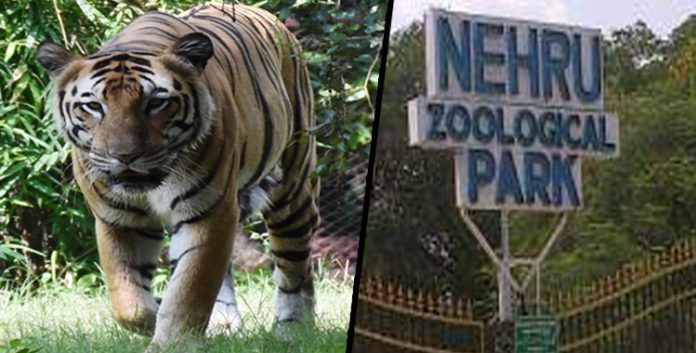Two big cats died in a span of two weeks taking a toll to 4 in a year
Hyderabad: While the coronavirus is ravaging the lives in human habitations, a rare disease is hunting the animals inside the Zoo Park where two tigers have died in a span of just two weeks raising many eyebrows in the circle of wildlife lovers.
An 11 years old young Royal Bengal tiger named Kadamba has breathed his last under the suspicious condition on Saturday. He was brought to the zoo park from Pilukula Biological Park, Mangalore only six years ago. Only two weeks ago on 25th June, a white tiger named Kiran succumbed to the disease after a weeklong treatment taking a death toll to four in a span of just 10 months.
According to the Zoo Authorities, unlike other cases, Kadamba did not show any signs of illness but was avoiding food frequently a few days earlier to his demise. According to the post mortem report, the official said, the big cat has died due to shock following congestive heart failure.
However, only two weeks ago an 8 years old white male tiger Kiran succumbed to the disease called Neoplastic, a Tumour that formed on the right side of the lower Jaw and gradually penetrates to the arteries in the heart that often leads to death of tigers. This disease is said to have hunting the big cats in the zoo park for several years.
In Kiran’s case, the cat was put under critical observation for three weeks before his death.
A post mortem report, following the death of Kiran, reveals that a hard mass of approximately 500 grams was found at his necrose extended into the Lower Jaw. “As the lungs were infiltrated with small Neoplastic tumors, the entire lung was damaged leading to the tiger’s death due to Asphyxia,” the release said.
Not long ago a 14 years old white tiger named Badri was died due to the same disease on 16th August last year. He was too suffering from a tumor in the neck which was weighted for five kilograms during post mortem. However, only 11 days earlier to Badri’s demise, one more death was reported from the Zoo Park and this time it was a 21 years old tiger named Vinay who said to have been breadth his last due to problems related to senility.
It is said that Kiran’s father Badri and grandfather Rudra both died due to same disease called Neoplastic Tumour at Jaw in the age of 12 and 14 respectively.
According to the officials, the life span of carnivores stands to 16 to 18 years in captivity and 12 years in wild. “Basically life span of species like cats and dogs are less compare to other herbivorous. At present we are housing 11 yellow tigers out of which 3 big cats have surpassed their lifespan. These yellow Royal Bengal tiger are of 19, 20 and 21 years old now but still kicking. Good amount of food, proper hygiene, medical care and efforts of zoo staff and management are the reason behind their increasing life span,” informed the official.


